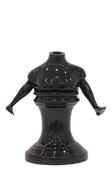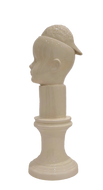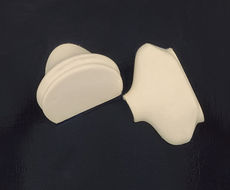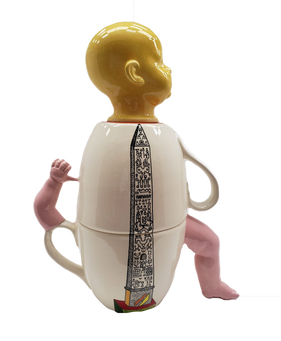Ivonne Ferrer
Humanity's Gambit

"Humanity's Gambit," 2021, ceramic sculpture (wooden base), 33 x 84 x 108"

"Humanity's Gambit," 2021, ceramic sculpture (wooden base), 33 x 84 x 108"

"Humanity's Gambit," 2021, ceramic sculpture (wooden base), 33 x 84 x 108"

"Humanity's Gambit," 2021, ceramic sculpture (wooden base), 33 x 84 x 108"
Ivonne Ferrer (b. Cuba) Graduated from San Alejandro Academy of Fine Arts, and René Portocarrero National Silk Screen Print Shop, Havana, Cuba. Already graduated, works as restorer of sculpture and painting in the Museum of the City of Havana. Following an initial solo exhibition of her works in Havana, Atribuciones in Fidelio Ponce Gallery (1990), that led her to take her first steps as a professional, she leaves her country of birth and moves to Madrid, where her reputation as an artist is solidified and where she quickly attains a place of prominence following two new solo exhibitions, La temperatura de Dios (1993) and Fisiología decorativa (1994). She also participates in numerous other projects and collective exhibitions: La isla mágica in Copenhagen, together with two masters, the Cuban Julio Girona and the Spaniard Fernando Somosa, and Fresca y bajita de sal in Genoa, Italy, with Aldo Menéndez, closing the period with a solid production for Expo Universal Sevilla 92, Arts Pavillion. Ivonne moves to the United States in 1995, in 1997 Trinomio cubano that opened at Botello Gallery in Hato Rey. She has exhibited her work in numerous and outstanding locations: 2002 The Permanent Collection, Museum of Latin American Art (MOLAA), California. 2003 Arcale International Art Fair, Salamanca. 2005 The Illustrated Book. A Marriage of Science and Art, FIU, Miami. 2005 Exhibition in tribute to María Sambrano, Museo de América, Madrid. 2006 Supermix, Contemporay Art in Miami, Edge Zones Gallery. 2009 Itinerant expo for America and Europa I Have a Dream. 2010 Soupe d’ escargot, Alliance Francaise, Miami. 2012 (R) Evolution Comics, Solo Exhibition, Aluna Art Foundation, Miami. 2014 Women at the edge of an island, Museum of de Cuban Art, Miami. 2015 Artistic License Gallery 91, Wynwood, Miami. 2016 Closeup Webber Gallery at College of Central Florida, Ocala, among other.
WORKS ON PAPER & CANVAS

No. 5, 2022, mixed media on canvas, 21 x 21"

No. 4, 2022, mixed media on canvas, custom frame, 21 x 21"

No. 3, 2022, mixed media on canvas, custom frame, 21 x 21"

No. 2, 2022, mixed media on canvas, custom frame, 21 x 21"

No. 1, 2022, mixed media on canvas, custom frame, 21x 21"

No. 1, Venus de Milo, 2022, mixed media on canvas, 21 x 21"

No. 2, Venus de Milo, 2022, mixed media on canvas, 21 x 21"

No. 5, 2022, acrylic on canvas, 48 x 48"

No. 1, 2022, mixed media on canvas, 21 x 21"

No. 2, 2022, mixed media on canvas, 21 x 21"

No. 3, 2022, mixed media on canvas, 21 x 21"

No. 4, 2022, mixed media on canvas, 21 x 21"
BRONZE
CERAMICS





















Ivonne Ferrer, 2022, hand painted ceramic mural, 30 x 42"

"No hay rayo que por bien no venga," 2020, hand painted ceramic mural, 6 x 5'

Ivonne Ferrer, 2022, hand painted ceramic mural, 30 x 42"
The creative imagination of Ivonne Ferrer
“Who in the World am I?” cried Alice.
Lewis Carroll, pseud. Alice’s Adventures in Wonderland, 1865
The creative imagination of Ivonne Ferrer produces works that are as bizarre as they are provocative. She invites us into a world of irony, satire, humor, and surrealism, always accomplished through meticulous draftsmanship, painterly and compositional skills. Only with a strong background in an academic system that demanded technical proficiencies and conceptual originality, could an artist succeed in making a body of work of such inventiveness. Giving credit to her education in Havana and an artistic tradition ranging from the academic to images from popular culture that continues to serve as inspiration, Ivonne Ferrer has brought her unique vision into another dimension in the cosmopolitan art scene of Miami, while never losing the powers of invention that have marked her career for many years. She continues to conceive and develop a strange cast of characters, dominated by women of all ages, descriptions, and historical sources. The female protagonists in her works introduce us to their stories, force remarkable readings of their dilemmas, real and imagined, and emerge heroic – even when they should be the victims. All her characters disguise an inexplicable and fantastic reality as they cavort in a world of fragments, distortions, and warped alterations devoid of time and place. Who in the world are they and what are they doing, or did they do, or will they do? These are the questions that Ivonne Ferrer provokes in her strange accumulations of images, oddities, and mise-en-scénes. For each work, she manages to construct new identities in allegorical twists that expand the complexities of an historical framework that sees the contemporary world through a new contextual lens.
There are a number of traits that emerge in her works and may be seen as part of a consistent vision to create a unique and surreal narrative through paint, collage, and appropriations from a variety of sources that descend from popular culture, Cuba’s remarkable graphic tradition, and the world of mythology and literature. Like Alice in Wonderland signified for Lewis Carroll both a confused exterior world she encountered on her travels, and her own fragmented behavior ever fluctuating between fantasy and reality, Ivonne Ferrer uses her imagination to relate her own personal narrative based on life’s and art’s experiences. Most of her work is self-referential in compositions that are not portraits in the strictest sense of straightforward depictions or even from stories that are fabricated in personally symbolic ways. It is the dynamic of her creations that involves a cycle of self-revelation and self-creation in a fictional narrative. The use of masquerade and similar devices through certain techniques, in particular, collage and photomontage, adds another level removed from reality and placed into her personal constructs. The self is constantly displaced with strategies of centering, erasing, mimicking, and outward projection of desire that challenge the senses, frequently in the most sardonic and humorous of ways. Often the scenes are not humorous at all, but a sad commentary on life’s travails, especially as they relate to political and social undercurrents not easily avoided or disguised. It is a fragmented story that exists as both metaphor and allegory and defies immediate translation as the viewer wrestles with perplexing meanings underlying what must be subversive in content, thus hidden.
The historic mixes with the contemporary; the social with the anti-social; popular customs with aesthetic canons. There are recognizable images of ancient statuary that contain their own messages over time; Metaphysical architectural impossibilities; commercial branding and ridiculous Dada combinations whose very absurdity sets the stage for the impossibility of the story within, while reminding the viewer it is a fantasy of the artist’s imagination. Using a Neo-Pop system of appropriation with comics, photographs, advertisements and other literary sources as material for idiosyncratic messages that may be understood by the artist alone, Ferrer seduces the viewer into partial understanding, further confusing her bizarre narrative. Heading down an ironic path and gathering a vast quantity of sources, and at the same time sabotaging them for new content, Ferrer emerges like a choreographer directing an accumulation of images into complicated collages to become aesthetic objects with their own inherent meaning based on a unique process of creation and combination. The essence of her work uses characteristic and formal methods of artistic discipline to not only subvert but to also entrench them into a new dystopian vision. Hers is an impure art world, afflicted by consumerist addiction, sexual inuendoes, depleted values, and decadent realities. Art objects are transformed into commodities amid a quest for progress that seems to go nowhere in her complex compositions. They make no sense; poised to self-destruct. What is the message the artist means to convey? How does she see the past interacting with the present through these combinations? There appears to be a symbolic language that meanders through the works and unites the selection of imagery – from the statuary to the literary. Symbols can be integrated in different ways and serve different purposes beyond the aesthetic. In popular culture, there is a belief in the multivalent quality of images, and a sense of interplay between those produced through technology and the society that has commodified them. The hand of the artist controls such juxtapositions that necessarily occur when a variety of materials are brought together as a collage with an intervention of original drawing and painting. It is this control, a formalistic skillset, that Yvonne Ferrer brings to works that express the surprising accumulation of images for the purpose of transcending the real world, as much as annexing so much of it as the chance encounters of time and place.
Carol Damian, Ph.D.








































